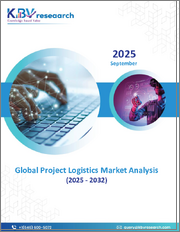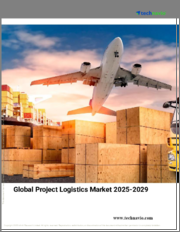
|
시장보고서
상품코드
1570901
프로젝트 물류 시장, 기회, 성장 촉진요인, 산업 동향 분석과 예측(2024-2032년)Project Logistics Market, Opportunity, Growth Drivers, Industry Trend Analysis and Forecast, 2024-2032 |
||||||
세계의 프로젝트 물류 시장은 2023년에 4,898억 달러로 평가되며, 2024-2032년 CAGR 6% 이상으로 성장할 전망입니다.
인프라 개발 및 대규모 산업 프로젝트에 대한 수요가 증가함에 따라 전문 물류 솔루션에 대한 수요가 증가하고 있습니다. 경제 성장과 도시화에 따라 복잡한 운송 및 공급망을 효과적으로 관리하는 것은 적시에 비용 효율적으로 프로젝트를 수행하는 데 필수적입니다. 또한 대형 화물을 수반하는 복잡한 세계 프로젝트가 증가함에 따라 국제 규정을 준수하고 귀중한 장비의 안전한 운송을 보장하는 안전하고 컴플라이언스를 준수하는 물류 서비스에 대한 수요가 증가하고 있습니다.
프로젝트 물류 산업은 서비스, 운송 형태, 산업, 지역별로 분류할 수 있습니다.
운송 분야는 도로, 철도, 해상, 항공 운송을 결합한 복합 운송 솔루션의 채택이 2023년 시장 점유율의 약 55%를 차지하며 견인했습니다. 이러한 접근 방식은 운송 시간을 단축하고 혼잡 문제를 해결하여 효율성을 높이고 대규모 프로젝트 부품의 적시 배송을 보장합니다. 또한 물류 프로바이더들은 경로를 최적화하고 실시간 추적을 위해 기술을 활용하고 있습니다. 첨단 소프트웨어와 데이터 분석은 혼란에 대처하고, 물류를 동적으로 관리하고, 공급망 가시성을 향상시키는 데 도움이 되고 있습니다. 이 기술 주도 전략은 복잡한 시나리오에서도 엄격한 배송 일정을 유지하면서 효율성을 높입니다.
석유 및 가스 분야는 2023년 시장 점유율의 약 30%를 차지할 것으로 예상되며, 원격지 및 까다로운 장소에서의 물류 최적화에 많은 관심을 기울이고 있습니다. 탐사가 어려운 지형으로 확장됨에 따라 물류 제공 업체는 고립된 현장으로 무거운 부품을 효율적이고 안전하게 운송하기 위해 첨단 기술과 특수 장비를 채택하고 있습니다. 또한 지정학적 긴장과 규제에 따른 위험을 줄이기 위해 업계는 공급망 탄력성을 우선순위로 삼고 있습니다. 운송 경로의 다양화, 재고 관리 강화, 실시간 모니터링과 같은 유연한 전략을 통해 중요한 물자와 장비의 중단 없는 배송을 보장하고 있습니다.
아시아태평양은 2023년 세계 프로젝트 물류 시장을 주도하며 약 35%의 점유율을 차지할 것으로 예상됩니다. 도시 개발, 교통망, 에너지 프로젝트에 대한 대규모 투자로 인해 크고 복잡한 화물을 처리할 수 있는 특수 물류 솔루션에 대한 수요가 증가하고 있습니다. 기업은 이 지역의 다양한 지역성과 인프라 문제를 해결하기 위해 맞춤형 물류 전략을 도입하여 필수 부품의 효율적이고 적시적인 배송을 실현하고 있습니다. 대규모 프로젝트 증가는 엄격한 일정과 프로젝트 요구 사항을 충족하기 위한 맞춤형 물류 관리의 필요성을 강조하고 있습니다.
목차
제1장 조사 방법과 조사 범위
제2장 개요
제3장 업계 인사이트
- 에코시스템 분석
- 공급업체 상황
- 물류 프로바이더
- 포장·상자포장 서비스
- 화물 운송 업자
- 창고 업자
- 설치·조립 서비스
- 최종사용자
- 이익률 분석
- 기술 혁신 상황
- 특허 분석
- 주요 뉴스와 구상
- 규제 상황
- 영향요인
- 촉진요인
- 대규모 인프라 프로젝트에 대한 수요 증가
- 재생에너지 프로젝트에 대한 투자의 증가
- 물류·운송 기술의 진보
- 세계화와 국제 무역의 확대
- 업계의 잠재적 리스크 & 과제
- 특수한 물류 솔루션에 수반하는 고비용
- 규제와 컴플라이언스의 과제
- 촉진요인
- 성장 가능성 분석
- Porter의 산업 분석
- PESTEL 분석
제4장 경쟁 구도
- 서론
- 기업 점유율 분석
- 경쟁 포지셔닝 매트릭스
- 전략 전망 매트릭스
제5장 시장 추산·예측 : 서비스별, 2021-2032년
- 주요 동향
- 운송
- 창고업
- 세관·규제 대응
- 기타
제6장 시장 추산·예측 : 운송 모드별, 2021-2032년
- 주요 동향
- 도로
- 철도
- 해상
- 항공
- 멀티모달
제7장 시장 추산·예측 : 산업별, 2021-2032년
- 주요 동향
- 석유 및 가스
- 건설
- 에너지
- 광업
- 제조업
- 기타
제8장 시장 추산·예측 : 지역별, 2021-2032년
- 주요 동향
- 북미
- 미국
- 캐나다
- 유럽
- 영국
- 독일
- 프랑스
- 스페인
- 이탈리아
- 러시아
- 북유럽
- 기타 유럽
- 아시아태평양
- 중국
- 인도
- 일본
- 한국
- 호주
- 동남아시아
- 기타 아시아태평양
- 라틴아메리카
- 브라질
- 멕시코
- 아르헨티나
- 기타 라틴아메리카
- 중동 및 아프리카
- UAE
- 남아프리카공화국
- 사우디아라비아
- 기타 중동 및 아프리카
제9장 기업 개요
- Agility Logistics
- C.H. Robinson
- CEVA Logistics
- Damco
- DB Schenker
- DHL
- DSV
- Expeditors International
- GEA Group
- GEODIS
- Hellmann Worldwide Logistics
- Kerry Logistics
- Kuehne+Nagel
- Mammoet
- Rhenus Logistics
- Sarens Group
- Sinotrans
- UPS Supply Chain Solutions
- XPO Logistics
- Yusen Logistics
The Global Project Logistics Market, valued at USD 489.8 billion in 2023, will grow at a CAGR of over 6% from 2024 to 2032. The escalating need for infrastructure development and large-scale industrial projects is driving the demand for specialized logistics solutions. As economies grow and urbanize, effectively managing complex transportation and supply chains is essential for ensuring timely and cost-efficient project execution. Additionally, the rise of intricate global projects involving oversized cargo increases the demand for secure and compliant logistics services, ensuring adherence to international regulations and the safe transport of valuable equipment.
The project logistics industry is segregated based on service, transportation mode, industry, and region.
The transportation segment held around 55% of the market share in 2023, driven by the adoption of multimodal solutions combining road, rail, sea, and air transport. This approach enhances efficiency by reducing transit times and addressing congestion issues, ensuring timely delivery of large-scale project components. Additionally, logistics providers are increasingly leveraging technology for route optimization and real-time tracking. Advanced software and data analytics help tackle disruptions, manage logistics dynamically, and improve supply chain visibility. This tech-driven strategy boosts efficiency while maintaining strict delivery schedules, even in complex scenarios.
The oil and gas segment held around 30% of the market share in 2023, with a growing focus on optimizing logistics for remote and challenging locations. As exploration expands into difficult terrains, logistics providers are adopting advanced technologies and specialized equipment to ensure efficient, safe transport of heavy components to isolated sites. Additionally, the industry is prioritizing supply chain resilience to mitigate risks from geopolitical tensions and regulations. Flexible strategies, such as diversifying transport routes, enhancing inventory management, and using real-time monitoring, ensure uninterrupted delivery of critical supplies and equipment.
Asia Pacific led the global project logistics market, capturing around 35% of the share in 2023, fueled by rapid infrastructure expansion across the region. Significant investments in urban development, transportation networks, and energy projects are driving the demand for specialized logistics solutions to handle oversized and complex shipments. Companies are implementing tailored logistics strategies to tackle the region's varied geography and infrastructure challenges, ensuring the efficient and timely delivery of essential components. The growth in large-scale projects highlights the need for tailored logistics management to meet strict timelines and project requirements.
Table of Contents
Chapter 1 Methodology and Scope
- 1.1 Research design
- 1.1.1 Research approach
- 1.1.2 Data collection methods
- 1.2 Base estimates and calculations
- 1.2.1 Base year calculation
- 1.2.2 Key trends for market estimates
- 1.3 Forecast model
- 1.4 Primary research and validation
- 1.4.1 Primary sources
- 1.4.2 Data mining sources
- 1.5 Market definitions
Chapter 2 Executive Summary
- 2.1 Industry 360° synopsis, 2021 - 2032
Chapter 3 Industry Insights
- 3.1 Industry ecosystem analysis
- 3.2 Supplier landscape
- 3.2.1 Logistics providers
- 3.2.2 Packaging and crating services
- 3.2.3 Freight forwarders
- 3.2.4 Warehousing providers
- 3.2.5 Installation and assembly services
- 3.2.6 End users
- 3.3 Profit margin analysis
- 3.4 Technology and innovation landscape
- 3.5 Patent analysis
- 3.6 Key news and initiatives
- 3.7 Regulatory landscape
- 3.8 Impact forces
- 3.8.1 Growth drivers
- 3.8.1.1 Growing demand for large-scale infrastructure projects
- 3.8.1.2 Increased investment in renewable energy projects
- 3.8.1.3 Technological advancements in logistics and transportation
- 3.8.1.4 Globalization and expansion of international trade
- 3.8.2 Industry pitfalls and challenges
- 3.8.2.1 High costs associated with specialized logistics solutions
- 3.8.2.2 Regulatory and compliance challenges
- 3.8.1 Growth drivers
- 3.9 Growth potential analysis
- 3.10 Porter's analysis
- 3.11 PESTEL analysis
Chapter 4 Competitive Landscape, 2023
- 4.1 Introduction
- 4.2 Company market share analysis
- 4.3 Competitive positioning matrix
- 4.4 Strategic outlook matrix
Chapter 5 Market Estimates and Forecast, By Service, 2021 - 2032 ($Bn)
- 5.1 Key trends
- 5.2 Transportation
- 5.3 Warehousing
- 5.4 Customs and Regulatory Compliance
- 5.5 Others
Chapter 6 Market Estimates and Forecast, By Transportation Mode, 2021 - 2032 ($Bn, 000' tons)
- 6.1 Key trends
- 6.2 Road
- 6.3 Rail
- 6.4 Sea
- 6.5 Air
- 6.6 Multi-modal
Chapter 7 Market Estimates and Forecast, By Industry, 2021 - 2032 ($Bn, 000' tons)
- 7.1 Key trends
- 7.2 Oil and Gas
- 7.3 Construction
- 7.4 Energy
- 7.5 Mining
- 7.6 Manufacturing
- 7.7 Others
Chapter 8 Market Estimates and Forecast, By Region, 2021 - 2032 ($Bn, 000' tons)
- 8.1 Key trends
- 8.2 North America
- 8.2.1 U.S.
- 8.2.2 Canada
- 8.3 Europe
- 8.3.1 UK
- 8.3.2 Germany
- 8.3.3 France
- 8.3.4 Spain
- 8.3.5 Italy
- 8.3.6 Russia
- 8.3.7 Nordics
- 8.3.8 Rest of Europe
- 8.4 Asia Pacific
- 8.4.1 China
- 8.4.2 India
- 8.4.3 Japan
- 8.4.4 South Korea
- 8.4.5 Australia
- 8.4.6 Southeast Asia
- 8.4.7 Rest of Asia Pacific
- 8.5 Latin America
- 8.5.1 Brazil
- 8.5.2 Mexico
- 8.5.3 Argentina
- 8.5.4 Rest of Latin America
- 8.6 MEA
- 8.6.1 UAE
- 8.6.2 South Africa
- 8.6.3 Saudi Arabia
- 8.6.4 Rest of MEA
Chapter 9 Company Profiles
- 9.1 Agility Logistics
- 9.2 C.H. Robinson
- 9.3 CEVA Logistics
- 9.4 Damco
- 9.5 DB Schenker
- 9.6 DHL
- 9.7 DSV
- 9.8 Expeditors International
- 9.9 GEA Group
- 9.10 GEODIS
- 9.11 Hellmann Worldwide Logistics
- 9.12 Kerry Logistics
- 9.13 Kuehne + Nagel
- 9.14 Mammoet
- 9.15 Rhenus Logistics
- 9.16 Sarens Group
- 9.17 Sinotrans
- 9.18 UPS Supply Chain Solutions
- 9.19 XPO Logistics
- 9.20 Yusen Logistics















